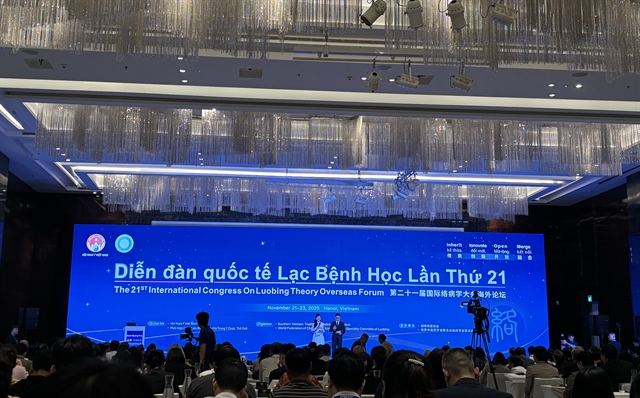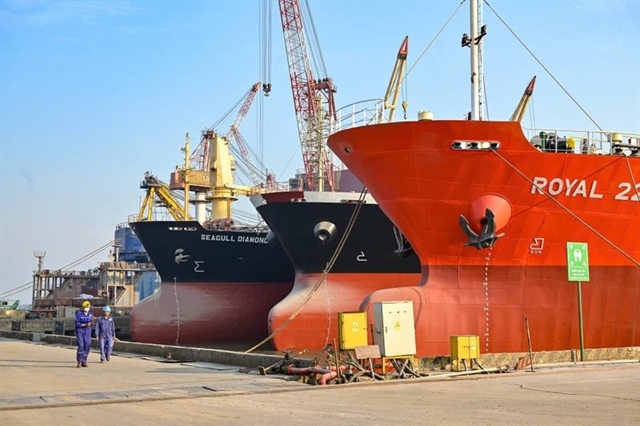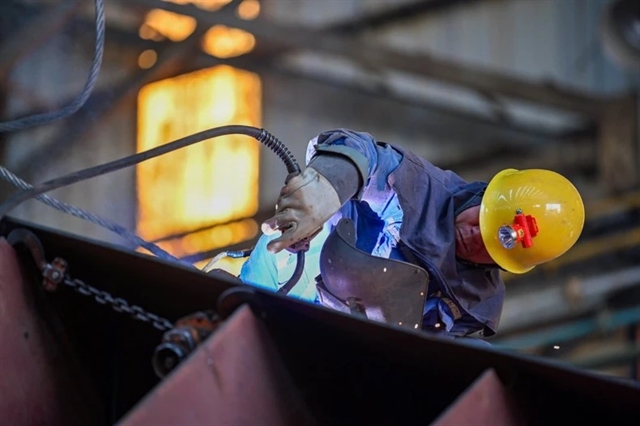 Society
Society

 |
| Shipbuilders walk on the Nam Triệu Wharf in Thuỷ Nguyên City, Hải Phòng, next to newly built 7,000-tonne oil tankers. — Photo nhandan.vn |
HẢI PHÒNG — Wind from the Nam Triệu Estuary in Thuỷ Nguyên City, on the outskirts of the northern port city of Hải Phòng, is bone-chillingly cold at night.
It pierces through the vast workshops of the Nam Triệu Shipbuilding One Member Co. Ltd. (NASICO) under the Shipbuilding Industry Corporation (SBIC).
But cold winter days are the best time for shipbuilders in the north.
Unhindered by heat and humidity, the workshops are busy day and night with the sound of steel and the flashes of welding.
At the end of 2024 and the beginning of 2025, the company received numerous orders, and the shipbuilders never stopped working.
Despite the hardship, they are proud of the products bearing the mark "made in Việt Nam".
Hard at work
At 1am, Nguyễn Văn Tuấn, a level five worker (the highest level) and team leader of Processing Team No. 4 at the Ship Hull Workshop, is still labouring with his colleagues to process and assemble steel components of a 65,000DWT bulk cargo ship.
After each shift, every completed steel block is transported by a specialised vehicle to the yard, lifted onto a slipway, and connected into sections to form a ship, bringing with it the pride of the Nam Triệu shipbuilding brand.
Tuấn started his career as a shipbuilder in late 1996. Since then, he has reached the highest level of a shipbuilder, with nearly 30 years of experience.
The small man from Hải Dương Province always works with passion and dedication. His greatest motivation is the love for the job.
This passion has kept him in the profession, even in times of extreme hardship -- such as upheavals in the shipbuilding industry or during the COVID-19 pandemic, when he had to work and live at the workshop for months.
Tuấn also met his life partner at NASICO, and his in-laws are experienced shipbuilding workers whose family has a long tradition in the industry.
He said that in their time, manual welding was mainly used, so shipbuilders had to work in a toxic environment with low productivity.
Nowadays, thanks to advances in science and technology, modern machines have been put into use, significantly improving working conditions and achieving productivity 2.5 times higher than with manual welding.
But improving workers' skills has become even more difficult.
For NASICO, training and improving the skills of their shipbuilders is a top priority.
Every year, the company organises exams to upgrade workers’ qualification levels.
 |
| A welder works in the Ship Hull Workshop at the Nam Triệu Shipbuilding Co. Ltd. — Photo nhandan.vn |
As technology develops and machinery becomes more complex, workers must regularly update their skills and adapt to new technology, gradually improving their professional qualifications and skills to create products that satisfy the most stringent requirements for domestic and international inspection organisations.
Tuấn said that workers must pass a theory test to sit the skills test.
The exam requires performing difficult shipbuilding techniques, such as adjusting the shaft of the stern tube. When building a new one, the worker must align its centre with less than 1.5mm of deviation.
“All must be done entirely by hand, without the help of machines. Evaluating the ability of a skilled worker is really not simple,” he said.
With such difficulties, female shipbuilders face even greater challenges.
But for Nguyễn Thị Cúc, a level 3/5 iron welder with 17 years of experience, the work is normal.
With a bright smile, the 47-year-old woman summarises her typical working day quite simply: “I start out very worried about the progress of work, but end up very proud of the results I create."
In production, welders must be highly focused and skilful, especially in handling difficult details, ensuring good technique, aesthetics and quality.
More importantly, workers must comply with regulations on labour safety and environmental hygiene.
For a woman like Cúc, no matter how tired she is, at the end of the working day, she still has to return home and take care of the family.
“Every woman wants to dress beautifully and do light work. But each person has their own thoughts, their own way of life, and their own favourite job. For me, protective clothing, gas masks and gloves are the most suitable outfits. Shipbuilders, whether male or female, only think: Go to work and return safely,” said Cúc.
Welders, mechanics and assemblers, along with many other divisions and workshops in the shipbuilding industry, have to face dangers, toxic substances and the risk of work accidents.
One young female worker, 29-year-old Vi Thị Vương, who is an ethnic Thái girl from the central province of Thanh Hoá, spoke about the hardships in the Metal Cleaning Workshop.
"Whether it is winter or summer, we always have to work in the vaults to sandblast, or clean off paint and rust. Although we are fully equipped with labour protection gear, including gas masks, with this working environment in a closed space with strong paint and grease smells, it is inevitable that there will be times when we get paint sickness, nausea and dizziness," she said.
Dedication
The most difficult time for NASICO shipbuilders was the same as for the industry in general: the economic recession of 2012-2014, when maritime transport stagnated, shipbuilding orders dropped dramatically, and workers were unemployed.
Tuấn said: “Both my wife and I worked in shifts, earning only 20 days a month, and we had to do other jobs. Every family of shipbuilders in our company was in the same situation. Fortunately, the company's leaders found every way to ensure income for workers to maintain their livelihoods.”
Head of the Organisation and Administration Divison Nguyễn Hoàng Hải said that not only workers, but many people working in management at that time also experienced economic pressures.
“Personally, after many sleepless nights thinking and considering carefully, I realised that when the company is in trouble, the most important thing is solidarity, a spirit of sharing the joys and sorrows of the collective,” said Hải.
After 10 years, the tireless efforts of all NASICO staff and employees have brought good results. Domestic and foreign partners have come to place a number of orders, ensuring jobs for workers over the next five years.
SBIC Acting General Director Trần Mạnh Hà commented: “The collective of officers and shipbuilders of NASICO in particular, and the entire corporation in general, with their deep love for the profession and strong will, always have faith and are ready to face all challenges and difficulties.
"They not only sweat and work hard to create modern ships, but also put into them their national pride and the aspiration to bring the Vietnamese shipbuilding industry far on the world map." — VNS